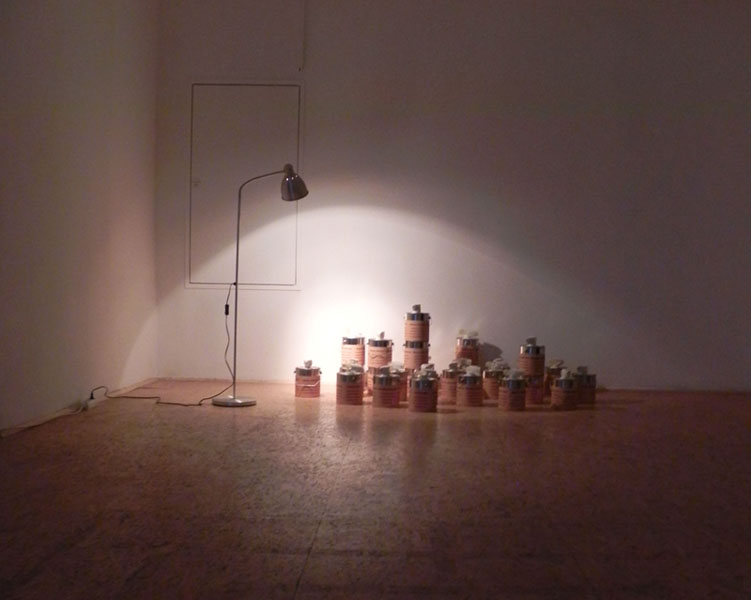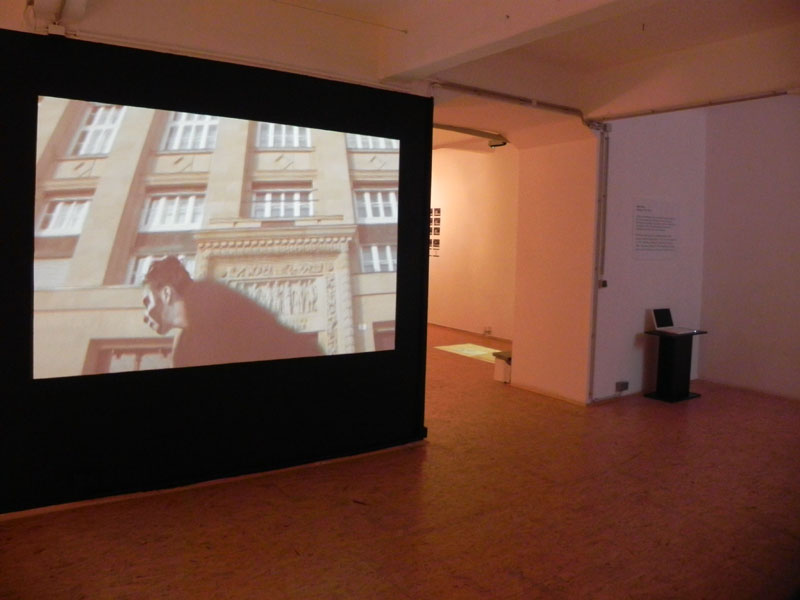Encounters in Relational Geography at Open Space, Vienna (Exhib Review)
Encounters in Relational Geography – Dust, Ashes, Residua, Open Space, Vienna, 2 June – 2 July 2010
The Viennese project art centre Open Space (http://openspace-zkp.org) created a profile for itself within a few years by showing the kind of art that is best described as “in between.” On the one hand, this was a conscious, strategic choice designed to make the most of the gulf that separates the mainstream from the alternative art scene, the center (Austria, Western Europe, North America) from the periphery (Eastern Europe). On the other hand, it could be seen as a strategy for visibility and survival in an intensely commodified culture. Open Space is the only venue in Vienna that, because of its non-profit nature, exhibits Eastern European art almost constantly and not only as an occasional political gimmick to commemorate the events of 1989.
The current exhibition provides an example of this commitment. Encounters in Relational Geography – Dust, Ashes, Residua, curated by Richard Appignanesi under the directorship of Gulsen Bal who initiated Open Space, attempts to elaborate on the question as to whether Central and South-Eastern Europe, which are generally referred to as Eastern Europe, should be considered a kind of European supplement, an unwelcome guest on the edge of the European table.
 Seven Eastern European artists were invited to comment on the ongoing neo-liberal, capitalist reconstruction and re-territorialization of Eastern Europe. As the exhibition’s accompanying brochure explains: “Vienna, the former imperial lynchpin of trans-territorial peoples, is the ideal ‘in-between’ site for this exhibition.” The selected works do not offer an answer, but rather offer different perspectives on the question posed by the exhibition’s title. Their central reference point is the documentary Curse of the Hedgehog by the Romanian anthropologist Dumitru Budrala. In this feature-length video one can observe and emotionally participate in the working life and survival tactics of the Baesi Roma community, a people known as the “broom-makers of Romania.” The exhibition connects the precarious livelihood of these people with the Arna-Jharna Museum in Rajasthan, India, and its long-term project of collecting brooms as a basis for documenting and conserving the material culture of Rajasthan. There are two significant links between the geography of the Baesi Roma and the Arna-Jharna Museum in Rajasthan: first, the broom-making, and second the origins of the European Roma in Rajasthan.
Seven Eastern European artists were invited to comment on the ongoing neo-liberal, capitalist reconstruction and re-territorialization of Eastern Europe. As the exhibition’s accompanying brochure explains: “Vienna, the former imperial lynchpin of trans-territorial peoples, is the ideal ‘in-between’ site for this exhibition.” The selected works do not offer an answer, but rather offer different perspectives on the question posed by the exhibition’s title. Their central reference point is the documentary Curse of the Hedgehog by the Romanian anthropologist Dumitru Budrala. In this feature-length video one can observe and emotionally participate in the working life and survival tactics of the Baesi Roma community, a people known as the “broom-makers of Romania.” The exhibition connects the precarious livelihood of these people with the Arna-Jharna Museum in Rajasthan, India, and its long-term project of collecting brooms as a basis for documenting and conserving the material culture of Rajasthan. There are two significant links between the geography of the Baesi Roma and the Arna-Jharna Museum in Rajasthan: first, the broom-making, and second the origins of the European Roma in Rajasthan.
 The Slovenian artist Sašo Sedla?ek directly refers to India in his work AcDcWc (Merda d´Artista). The technologies developed by the poorest strata of Indian society for recycling excrement to turn it into energy are represented in his work by light bulbs that have been plugged into tins of artist’s shit (a nod to Manzoni) and surrounded by an intensely sweet aroma in the air. Another, more direct link to such relational geography is provided in two photographs by Romanian artist Vlad Nanc?. One of them depicts a finished birch broom similar to those made by the Baesi for sale or barter. The other shows the same broom in a reversed position so that it appears like a plant in a large jar of water. This second configuration is all about natural process – the broom growing roots and new leaves, and thus contributing to a healthy environment.
The Slovenian artist Sašo Sedla?ek directly refers to India in his work AcDcWc (Merda d´Artista). The technologies developed by the poorest strata of Indian society for recycling excrement to turn it into energy are represented in his work by light bulbs that have been plugged into tins of artist’s shit (a nod to Manzoni) and surrounded by an intensely sweet aroma in the air. Another, more direct link to such relational geography is provided in two photographs by Romanian artist Vlad Nanc?. One of them depicts a finished birch broom similar to those made by the Baesi for sale or barter. The other shows the same broom in a reversed position so that it appears like a plant in a large jar of water. This second configuration is all about natural process – the broom growing roots and new leaves, and thus contributing to a healthy environment.
 Residua (1976 – 2010) by Croatia-based Ranko Bon is introduced in a brief textual description on a wall placard. The work itself, however, exists in virtual space in a state of “perpetual progress.” It exists purely online and functions roughly like Wikipedia, even though it was started already in 1976, long before the rise of the online encyclopedia. Residua demonstrates the shifts that have occurred between 1976 and 2010 in digital media – changes enforced by ideology, by the global application of digital technologies, and by changes in the means of art production. And, of course, it documents those changes that have developed within the work itself as, in the meantime, it has acquired a history long enough for those new trends to emerge. In the end, the meaning of Residua lies not so much in its individual components but in its accumulation of a wealth of collected notes, essays, stories, jokes and other forms of language.
Residua (1976 – 2010) by Croatia-based Ranko Bon is introduced in a brief textual description on a wall placard. The work itself, however, exists in virtual space in a state of “perpetual progress.” It exists purely online and functions roughly like Wikipedia, even though it was started already in 1976, long before the rise of the online encyclopedia. Residua demonstrates the shifts that have occurred between 1976 and 2010 in digital media – changes enforced by ideology, by the global application of digital technologies, and by changes in the means of art production. And, of course, it documents those changes that have developed within the work itself as, in the meantime, it has acquired a history long enough for those new trends to emerge. In the end, the meaning of Residua lies not so much in its individual components but in its accumulation of a wealth of collected notes, essays, stories, jokes and other forms of language.
 The Austrian Isa Rosenberger is on a quest for the visual and performative means of representing the intertwined and blurred processes that comprise the contemporary economic and political machine. Her video ESPIRAL: A Dance of Death discusses how the invasion of Austrian banks affects the transitional processes in Eastern Europe. The overlapping layers of Rosenberger’s investigation — dance, aesthetics, language; capital expansion; Austria, East Europe, South America — succeed in provoking encounters between social and political geography. The video adopts and re-interprets the work of the German choreographer Kurt Jooss, the inventor of political ballet in Germany during the Weimar Republic and the rise of National Socialism. Rosenberger also employs economic theory from a text by Hannes Hoffbauer on Austrian financial imperialism. In doing so, the artist succeeds in extending her work beyond visual and performative expression, and attempt to de/link art, culture, capital – and thus the role of the art – in neo-liberal capitalist societies. An added pleasure of this film is the sight of a contemporary Chilean dancer, a follower of the Jooss method who verbally intervenes as Rosenberger puts on her skull-like make-up. In this manner, the medium of dance is modified through another medium, language.
The Austrian Isa Rosenberger is on a quest for the visual and performative means of representing the intertwined and blurred processes that comprise the contemporary economic and political machine. Her video ESPIRAL: A Dance of Death discusses how the invasion of Austrian banks affects the transitional processes in Eastern Europe. The overlapping layers of Rosenberger’s investigation — dance, aesthetics, language; capital expansion; Austria, East Europe, South America — succeed in provoking encounters between social and political geography. The video adopts and re-interprets the work of the German choreographer Kurt Jooss, the inventor of political ballet in Germany during the Weimar Republic and the rise of National Socialism. Rosenberger also employs economic theory from a text by Hannes Hoffbauer on Austrian financial imperialism. In doing so, the artist succeeds in extending her work beyond visual and performative expression, and attempt to de/link art, culture, capital – and thus the role of the art – in neo-liberal capitalist societies. An added pleasure of this film is the sight of a contemporary Chilean dancer, a follower of the Jooss method who verbally intervenes as Rosenberger puts on her skull-like make-up. In this manner, the medium of dance is modified through another medium, language.
Czech artist Zbyn?k Baladrán plays a formal game with the medium of film in his video essay, Bookcase. In this film, a hand is seen making up a list of books (it is unclear if the books on the list have been read or are being scheduled for future reading). Next, an architecture textbook from the Socialist era is opened and placed on the table alongside the list. The entire video is shot from above and then projected on the gallery floor.
The most complex work in the exhibition is the video Naked Freedom by Slovenian artist/filmmaker duo Marina Grzini? and Aina Šmid. Their reflections on the role of (video) art, technology, bio-politics, capital, and ideology as overlapping processes that sustain the functioning of contemporary societies seem to dismantle the idea of encounters in relational geography. Grzini? and Šmid include references to the theoreticians Beller, Kopac, Lopez Petit, Deleuze, Nimako, but also to Soviet filmmakers Dziga Vertov and Sergei Eisenstein. Their video installation re-invents the historical performative strategies of the ex-Yugoslav art scene of the 1980s, such as the Slovenian punk band Laibach’s mockery of totalitarian rituals. These newly vitalized strategies are being projected onto the conditions of contemporary video art and they allow the “capitalized” artwork to turn against itself.
The exhibition at Open Space views Eastern Europe as a kind of creative surplus value on the fringes of the continent. It’s not the exotic “new orient” we hoped to discover in 1989, but it’s still a space for productive encounters, cross-cultural confrontations, and unsuspected geographic relations.



